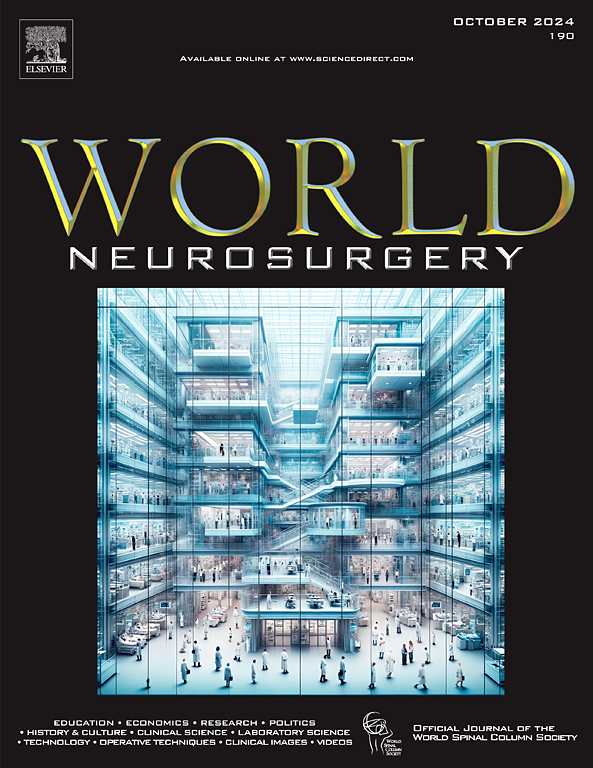椎旁肌退变影响退行性腰椎侧凸患者的冠状平衡。
IF 1.9
4区 医学
Q3 CLINICAL NEUROLOGY
引用次数: 0
摘要
目的:本研究旨在探讨椎旁肌(PSM)退变对退行性腰椎侧凸(DLS)患者冠状平衡的影响。方法:在这项回顾性横断面研究中,回顾了127例接受脊柱融合手术的DLS患者。术前x线和mri评估PSM变性,测量多裂肌(MF)和竖脊肌(ES)的横截面积(CSA)和脂肪浸润率(FIR)。计算了凸边与凹边的比值,即RCSA和RFIR。根据冠状平衡距离(CBD)将冠状平衡分为A型、B型和C型。采用单因素方差分析和多元logistic回归分析PSM参数及失衡的危险因素。结果:MF的RFIR和ES的RCSA在冠状平衡类型之间存在显著差异(p=0.009)。结论:PSM退变,特别是MF和ES的退变,显著影响DLS患者的冠状平衡。术前评估这些因素对于优化手术效果至关重要。本文章由计算机程序翻译,如有差异,请以英文原文为准。
Paravertebral Muscle Degeneration Affects Coronal Balance in Patients with Degenerative Lumbar Scoliosis
Objective
This study aimed to investigate the impact of paraspinal muscle (PSM) degeneration on coronal balance in patients with degenerative lumbar scoliosis (DLS).
Methods
In this retrospective cross-sectional study, 127 DLS patients who underwent spinal fusion surgery were reviewed. Preoperative x-rays and magnetic resonance images were used to assess PSM degeneration, measured by the cross-sectional area (CSA) and fat infiltration rate (FIR) of the multifidus (MF) and erector spinae (ES) muscles. The ratios of the convex to concave sides, namely RCSA and RFIR, were calculated. Coronal balance was classified into types A, B, and C based on the coronal balance distance. One-way analysis of variance and multiple logistic regression were performed to analyze PSM parameters and risk factors for imbalance.
Results
Significant differences were found among the coronal balance types in the RFIR of MF (P = 0.009), RCSA of ES (P < 0.001), FIR of ES (P = 0.017), and RFIR of ES (P = 0.001). Multiple logistic regression identified the RCSA and RFIR of ES as significant for type B imbalance, while the RFIR of MF and FIR of ES were significant for type C.
Conclusions
PSM degeneration, particularly in the MF and ES muscles, significantly affects coronal balance in DLS patients. Preoperative evaluation of these factors is essential for optimizing surgical outcomes.
求助全文
通过发布文献求助,成功后即可免费获取论文全文。
去求助
来源期刊

World neurosurgery
CLINICAL NEUROLOGY-SURGERY
CiteScore
3.90
自引率
15.00%
发文量
1765
审稿时长
47 days
期刊介绍:
World Neurosurgery has an open access mirror journal World Neurosurgery: X, sharing the same aims and scope, editorial team, submission system and rigorous peer review.
The journal''s mission is to:
-To provide a first-class international forum and a 2-way conduit for dialogue that is relevant to neurosurgeons and providers who care for neurosurgery patients. The categories of the exchanged information include clinical and basic science, as well as global information that provide social, political, educational, economic, cultural or societal insights and knowledge that are of significance and relevance to worldwide neurosurgery patient care.
-To act as a primary intellectual catalyst for the stimulation of creativity, the creation of new knowledge, and the enhancement of quality neurosurgical care worldwide.
-To provide a forum for communication that enriches the lives of all neurosurgeons and their colleagues; and, in so doing, enriches the lives of their patients.
Topics to be addressed in World Neurosurgery include: EDUCATION, ECONOMICS, RESEARCH, POLITICS, HISTORY, CULTURE, CLINICAL SCIENCE, LABORATORY SCIENCE, TECHNOLOGY, OPERATIVE TECHNIQUES, CLINICAL IMAGES, VIDEOS
 求助内容:
求助内容: 应助结果提醒方式:
应助结果提醒方式:


